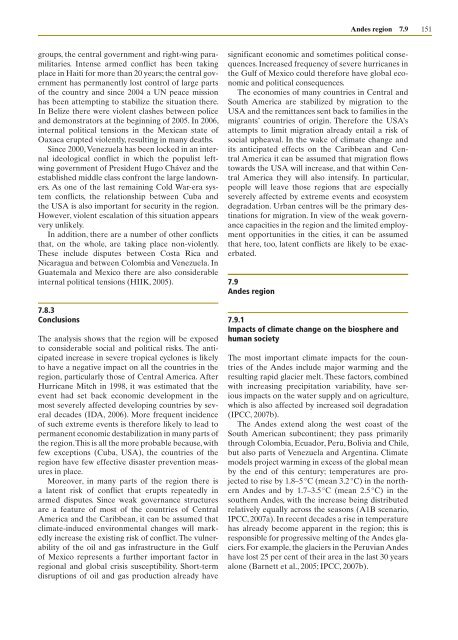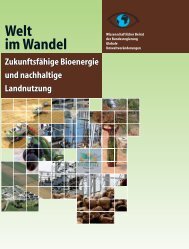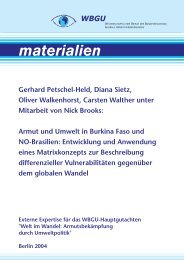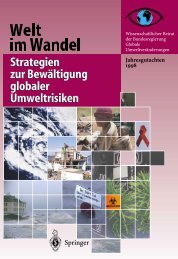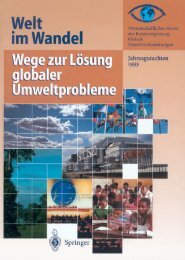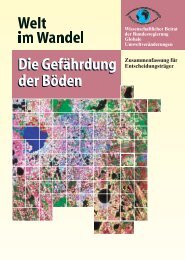World in Transition: Climate Change as a Security Risk - WBGU
World in Transition: Climate Change as a Security Risk - WBGU
World in Transition: Climate Change as a Security Risk - WBGU
Create successful ePaper yourself
Turn your PDF publications into a flip-book with our unique Google optimized e-Paper software.
groups, the central government and right-w<strong>in</strong>g paramilitaries.<br />
Intense armed conflict h<strong>as</strong> been tak<strong>in</strong>g<br />
place <strong>in</strong> Haiti for more than 20 years; the central government<br />
h<strong>as</strong> permanently lost control of large parts<br />
of the country and s<strong>in</strong>ce 2004 a UN peace mission<br />
h<strong>as</strong> been attempt<strong>in</strong>g to stabilize the situation there.<br />
In Belize there were violent cl<strong>as</strong>hes between police<br />
and demonstrators at the beg<strong>in</strong>n<strong>in</strong>g of 2005. In 2006,<br />
<strong>in</strong>ternal political tensions <strong>in</strong> the Mexican state of<br />
Oaxaca erupted violently, result<strong>in</strong>g <strong>in</strong> many deaths.<br />
S<strong>in</strong>ce 2000, Venezuela h<strong>as</strong> been locked <strong>in</strong> an <strong>in</strong>ternal<br />
ideological conflict <strong>in</strong> which the populist leftw<strong>in</strong>g<br />
government of President Hugo Chávez and the<br />
established middle cl<strong>as</strong>s confront the large landowners.<br />
As one of the l<strong>as</strong>t rema<strong>in</strong><strong>in</strong>g Cold War-era system<br />
conflicts, the relationship between Cuba and<br />
the USA is also important for security <strong>in</strong> the region.<br />
However, violent escalation of this situation appears<br />
very unlikely.<br />
In addition, there are a number of other conflicts<br />
that, on the whole, are tak<strong>in</strong>g place non-violently.<br />
These <strong>in</strong>clude disputes between Costa Rica and<br />
Nicaragua and between Colombia and Venezuela. In<br />
Guatemala and Mexico there are also considerable<br />
<strong>in</strong>ternal political tensions (HIIK, 2005).<br />
7.8.3<br />
Conclusions<br />
The analysis shows that the region will be exposed<br />
to considerable social and political risks. The anticipated<br />
<strong>in</strong>cre<strong>as</strong>e <strong>in</strong> severe tropical cyclones is likely<br />
to have a negative impact on all the countries <strong>in</strong> the<br />
region, particularly those of Central America. After<br />
Hurricane Mitch <strong>in</strong> 1998, it w<strong>as</strong> estimated that the<br />
event had set back economic development <strong>in</strong> the<br />
most severely affected develop<strong>in</strong>g countries by several<br />
decades (IDA, 2006). More frequent <strong>in</strong>cidence<br />
of such extreme events is therefore likely to lead to<br />
permanent economic destabilization <strong>in</strong> many parts of<br />
the region. This is all the more probable because, with<br />
few exceptions (Cuba, USA), the countries of the<br />
region have few effective dis<strong>as</strong>ter prevention me<strong>as</strong>ures<br />
<strong>in</strong> place.<br />
Moreover, <strong>in</strong> many parts of the region there is<br />
a latent risk of conflict that erupts repeatedly <strong>in</strong><br />
armed disputes. S<strong>in</strong>ce weak governance structures<br />
are a feature of most of the countries of Central<br />
America and the Caribbean, it can be <strong>as</strong>sumed that<br />
climate-<strong>in</strong>duced environmental changes will markedly<br />
<strong>in</strong>cre<strong>as</strong>e the exist<strong>in</strong>g risk of conflict. The vulnerability<br />
of the oil and g<strong>as</strong> <strong>in</strong>fr<strong>as</strong>tructure <strong>in</strong> the Gulf<br />
of Mexico represents a further important factor <strong>in</strong><br />
regional and global crisis susceptibility. Short-term<br />
disruptions of oil and g<strong>as</strong> production already have<br />
significant economic and sometimes political consequences.<br />
Incre<strong>as</strong>ed frequency of severe hurricanes <strong>in</strong><br />
the Gulf of Mexico could therefore have global economic<br />
and political consequences.<br />
The economies of many countries <strong>in</strong> Central and<br />
South America are stabilized by migration to the<br />
USA and the remittances sent back to families <strong>in</strong> the<br />
migrants’ countries of orig<strong>in</strong>. Therefore the USA’s<br />
attempts to limit migration already entail a risk of<br />
social upheaval. In the wake of climate change and<br />
its anticipated effects on the Caribbean and Central<br />
America it can be <strong>as</strong>sumed that migration flows<br />
towards the USA will <strong>in</strong>cre<strong>as</strong>e, and that with<strong>in</strong> Central<br />
America they will also <strong>in</strong>tensify. In particular,<br />
people will leave those regions that are especially<br />
severely affected by extreme events and ecosystem<br />
degradation. Urban centres will be the primary dest<strong>in</strong>ations<br />
for migration. In view of the weak governance<br />
capacities <strong>in</strong> the region and the limited employment<br />
opportunities <strong>in</strong> the cities, it can be <strong>as</strong>sumed<br />
that here, too, latent conflicts are likely to be exacerbated.<br />
7.9<br />
Andes region<br />
Andes region 7.9<br />
7.9.1<br />
Impacts of climate change on the biosphere and<br />
human society<br />
The most important climate impacts for the countries<br />
of the Andes <strong>in</strong>clude major warm<strong>in</strong>g and the<br />
result<strong>in</strong>g rapid glacier melt. These factors, comb<strong>in</strong>ed<br />
with <strong>in</strong>cre<strong>as</strong><strong>in</strong>g precipitation variability, have serious<br />
impacts on the water supply and on agriculture,<br />
which is also affected by <strong>in</strong>cre<strong>as</strong>ed soil degradation<br />
(IPCC, 2007b).<br />
The Andes extend along the west co<strong>as</strong>t of the<br />
South American subcont<strong>in</strong>ent; they p<strong>as</strong>s primarily<br />
through Colombia, Ecuador, Peru, Bolivia and Chile,<br />
but also parts of Venezuela and Argent<strong>in</strong>a. <strong>Climate</strong><br />
models project warm<strong>in</strong>g <strong>in</strong> excess of the global mean<br />
by the end of this century; temperatures are projected<br />
to rise by 1.8–5 °C (mean 3.2 °C) <strong>in</strong> the northern<br />
Andes and by 1.7–3.5 °C (mean 2.5 °C) <strong>in</strong> the<br />
southern Andes, with the <strong>in</strong>cre<strong>as</strong>e be<strong>in</strong>g distributed<br />
relatively equally across the se<strong>as</strong>ons (A1B scenario,<br />
IPCC, 2007a). In recent decades a rise <strong>in</strong> temperature<br />
h<strong>as</strong> already become apparent <strong>in</strong> the region; this is<br />
responsible for progressive melt<strong>in</strong>g of the Andes glaciers.<br />
For example, the glaciers <strong>in</strong> the Peruvian Andes<br />
have lost 25 per cent of their area <strong>in</strong> the l<strong>as</strong>t 30 years<br />
alone (Barnett et al., 2005; IPCC, 2007b).<br />
151


